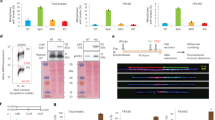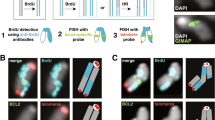Abstract
Fragile sites are chromosomal loci with a propensity to form gaps or breaks during early mitosis, and their instability is implicated as being causative in certain neurological disorders and cancers1. Recent work has demonstrated that the so-called common fragile sites (CFSs) often impair the faithful disjunction of sister chromatids in mitosis2. However, the mechanisms by which CFSs express their fragility, and the cellular factors required to suppress CFS instability, remain largely undefined. Here, we report that the DNA structure-specific nuclease MUS81–EME1 localizes to CFS loci in early mitotic cells, and promotes the cytological appearance of characteristic gaps or breaks observed at CFSs in metaphase chromosomes. These data indicate that CFS breakage is an active, MUS81–EME1-dependent process, and not a result of inadvertent chromatid rupturing during chromosome condensation. Moreover, CFS cleavage by MUS81–EME1 promotes faithful sister chromatid disjunction. Our findings challenge the prevailing view that CFS breakage is a nonspecific process that is detrimental to cells, and indicate that CFS cleavage actually promotes genome stability.
This is a preview of subscription content, access via your institution
Access options
Subscribe to this journal
Receive 12 print issues and online access
$209.00 per year
only $17.42 per issue
Buy this article
- Purchase on Springer Link
- Instant access to full article PDF
Prices may be subject to local taxes which are calculated during checkout





Similar content being viewed by others
References
Debacker, K. & Kooy, R. F. Fragile sites and human disease. Hum. Mol. Genet. 16, R150–R158 (2007).
Chan, K. L., Palmai-Pallag, T., Ying, S. & Hickson, I. D. Replication stress induces sister-chromatid bridging at fragile site loci in mitosis. Nat. Cell Biol. 11, 753–760 (2009).
Durkin, S. G. & Glover, T. W. Chromosome fragile sites. Annu. Rev. Genet. 41, 169–192 (2007).
Arlt, M. F., Casper, A. M. & Glover, T. W. Common fragile sites. Cytogenet. Genome Res. 100, 92–100 (2003).
Burrow, A. A., Marullo, A., Holder, L. R. & Wang, Y. H. Secondary structure formation and DNA instability at fragile site FRA16B. Nucleic Acids Res. 38, 2865–2877 (2010).
Letessier, A. et al. Cell-type-specific replication initiation programs set fragility of the FRA3B fragile site. Nature 470, 120–123 (2011).
Helmrich, A., Ballarino, M. & Tora, L. Collisions between replication and transcription complexes cause common fragile site instability at the longest human genes. Mol. Cell 44, 966–977 (2011).
Naim, V. & Rosselli, F. The FANC pathway and BLM collaborate during mitosis to prevent micro-nucleation and chromosome abnormalities. Nat. Cell Biol. 11, 761–768 (2009).
Chan, K. L., North, P. S. & Hickson, I. D. BLM is required for faithful chromosome segregation and its localization defines a class of ultrafine anaphase bridges. EMBO J. 26, 3397–3409 (2007).
Baumann, C., Korner, R., Hofmann, K. & Nigg, E. A. PICH, a centromere-associated SNF2 family ATPase, is regulated by Plk1 and required for the spindle checkpoint. Cell 128, 101–114 (2007).
Lukas, C. et al. 53BP1 nuclear bodies form around DNA lesions generated by mitotic transmission of chromosomes under replication stress. Nat. Cell Biol. 13, 243–253 (2011).
Harrigan, J. A. et al. Replication stress induces 53BP1-containing OPT domains in G1 cells. J. Cell Biol. 193, 97–108 (2011).
Hanada, K. et al. The structure-specific endonuclease Mus81 contributes to replication restart by generating double-strand DNA breaks. Nat. Struct. Mol Biol. 14, 1096–1104 (2007).
Davies, S. L., North, P. S. & Hickson, I. D. Role for BLM in replication-fork restart and suppression of origin firing after replicative stress. Nat. Struct. Mol. Biol. 14, 677–679 (2007).
Ciccia, A., McDonald, N. & West, S. C. Structural and functional relationships of the XPF/MUS81 family of proteins. Annu. Rev. Biochem. 77, 259–287 (2008).
Ciccia, A., Constantinou, A. & West, S. C. Identification and characterizationof the human mus81-eme1 endonuclease. J. Biol. Chem. 278, 25172–25178 (2003).
Osman, F., Dixon, J., Doe, C. L. & Whitby, M. C. Generating crossovers by resolution of nicked Holliday junctions: a role for Mus81-Eme1 in meiosis. Mol. Cell 12, 761–774 (2003).
Boddy, M. N. et al. Mus81-Eme1 are essential components of a Holliday junction resolvase. Cell 107, 537–548 (2001).
Whitby, M. C., Osman, F. & Dixon, J. Cleavage of model replication forks by fission yeast Mus81-Eme1 and budding yeast Mus81-Mms4. J. Biol. Chem. 278, 6928–6935 (2003).
Doe, C. L., Ahn, J. S., Dixon, J. & Whitby, M. C. Mus81-Eme1 and Rqh1 involvement in processing stalled and collapsed replication forks. J. Biol. Chem. 277, 32753–32759 (2002).
Interthal, H. & Heyer, W. D. MUS81 encodes a novel helix-hairpin-helix protein involved in the response to UV- and methylation-induced DNA damage in Saccharomyces cerevisiae. Mol. Gen. Genet. 263, 812–827 (2000).
Boddy, M. N. et al. Damage tolerance protein Mus81 associates with the FHA1 domain of checkpoint kinase Cds1. Mol. Cell Biol. 20, 8758–8766 (2000).
Bastin-Shanower, S. A., Fricke, W. M., Mullen, J. R. & Brill, S. J. The mechanism of Mus81-Mms4 cleavage site selection distinguishes it from the homologous endonuclease Rad1-Rad10. Mol. Cell Biol. 23, 3487–3496 (2003).
Forment, J. V., Blasius, M., Guerini, I. & Jackson, S. P. Structure-specific DNA endonuclease Mus81/Eme1 generates DNA damage caused by Chk1 inactivation. PLoS One 6, e23517 (2011).
Wechsler, T., Newman, S. & West, S. C. Aberrant chromosome morphology in human cells defective for Holliday junction resolution. Nature 471, 642–646 (2011).
Gallo-Fernandez, M., Saugar, I., Ortiz-Bazan, M. A., Vazquez, M. V. & Tercero, J. A. Cell cycle-dependent regulation of the nuclease activity of Mus81-Eme1/Mms4. Nucleic Acids Res. 40, 8325–8335 (2012).
Ke, Y. et al. PICH and BLM limit histone association with anaphase centromeric DNA threads and promote their resolution. EMBO J. 30, 3309–3321 (2011).
El-Zein, R. A. et al. Cytokinesis-blocked micronucleus assay as a novel biomarker for lung cancer risk. Cancer Res. 66, 6449–6456 (2006).
Henry-Mowatt, J. et al. XRCC3 and Rad51 modulate replication fork progression on damaged vertebrate chromosomes. Mol. Cell 11, 1109–1117 (2003).
Savic, V. et al. Formation of dynamic gamma-H2AX domains along broken DNA strands is distinctly regulated by ATM and MDC1 and dependent on H2AX densities in chromatin. Mol. Cell 34, 298–310 (2009).
Davies, S. L., North, P. S., Dart, A., Lakin, N. D. & Hickson, I. D. Phosphorylation of the Bloom’s syndrome helicase and its role in recovery from S-phase arrest. Mol. Cell Biol. 24, 1279–1291 (2004).
Acknowledgements
Work in the authors’ laboratory is supported by Cancer Research UK, The Nordea Foundation, The Association of International Cancer Research, The Danish Cancer Society, and the National Natural Science Foundation of China.
Author information
Authors and Affiliations
Contributions
S.Y., S.M., K.L.C., T.P-P., W.K.C., T.W. and Y.L. performed experimental work and data analysis. S.Y., S.M., K.L.C., H.W.M.,. Y.L. and I.D.H. planned the project and analysed data. S.Y., S.M., H.W.M., Y.L. and I.D.H. wrote the manuscript.
Corresponding authors
Ethics declarations
Competing interests
The authors declare no competing financial interests.
Supplementary information
Supplementary Information
Supplementary Information (PDF 353 kb)
Rights and permissions
About this article
Cite this article
Ying, S., Minocherhomji, S., Chan, K. et al. MUS81 promotes common fragile site expression. Nat Cell Biol 15, 1001–1007 (2013). https://doi.org/10.1038/ncb2773
Received:
Accepted:
Published:
Issue Date:
DOI: https://doi.org/10.1038/ncb2773
This article is cited by
-
Mitotic DNA synthesis in response to replication stress requires the sequential action of DNA polymerases zeta and delta in human cells
Nature Communications (2023)
-
UBE2T resolves transcription-replication conflicts and protects common fragile sites in primordial germ cells
Cellular and Molecular Life Sciences (2023)
-
FANCD2 promotes mitotic rescue from transcription-mediated replication stress in SETX-deficient cancer cells
Communications Biology (2022)
-
The RAD51 recombinase protects mitotic chromatin in human cells
Nature Communications (2021)
-
FANCD2 modulates the mitochondrial stress response to prevent common fragile site instability
Communications Biology (2021)



